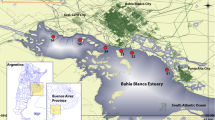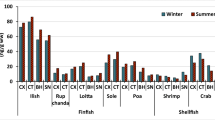Abstract
A newly analytical method based on QuEChERS extraction followed by gas chromatography with mass spectrometry (GC-MS) analysis was developed and validated for the quantification of 18 PCBs in wild (from Matosinhos Beach, Portugal) and cultivated (from Ria de Arousa, Spain) mussel samples, pooled by sex. Wild animals showed higher PCB levels than cultivated mussels, with males from both origins, presenting an upper contamination profile comparing with females. This fact seems to be correlated with few biometric parameters, but other interdependencies, not addressed herein, such as distinct lipid contents between sexes, as a consequence of the gametogenic stage, may also explain this data. Overall, data reiterate the importance of investigating the presence of PCBs in marine biological samples, which can act both as bioindicators of environmental contamination, either as food quality controls for human health.



Similar content being viewed by others
References
Alvarez Piñeiro ME, Simal Lozano J, Lage Yusty MA (1995) Organochlorine compounds in mussels of the estuarine bays of Galicia (North-West Spain). Mar Pollut Bull 30:484–487. doi:10.1016/0025-326X(95)00060-Z
Anastassiades M, Lehotay SJ, Stajnbaher D, Schenck FJ (2003) Fast and easy multiresidue method employing acetonitrile extraction/partitioning and "dispersive solid-phase extraction" for the determination of pesticide residues in produce. J AOAC Int 86:412–431
Anastassiades M, Scherbaum E, Taşdelen B, Štajnbaher D (2007) Recent developments in QuEChERS methodology for pesticide multiresidue analysis. In: Ohkawa H, Miyagawa H, Lee FW (eds) Pesticide Chemistry - Crop Protection, Public Health. Environmental Safety. Wiley-VCH Verlag GmbH & Co. KGaA, Germany, pp 439–458
Andral B, Stanisiere JY, Sauzade D, Damier E, Thebault H, Galgani F, Boissery P (2004) Monitoring chemical contamination levels in the Mediterranean based on the use of mussel caging. Mar Pollut Bull 49:704–712. doi:10.1016/j.marpolbul.2004.05.008
Antunes P, Gil O, Costa O (2001) Accumulation pathways of PCBs in sea bass from Ria de Aveiro, Portugal. Ecotoxicol Environ Restor 4:39–44
ARH-Norte—Administração da Região Hidrográfica do Norte (2011) Águas balneares costeiras, programa oficial de monitorização na região norte de acordo com o Decreto-Lei 135/2009, 3 de Julho (Dir. 2006/7/CE). http://www.arhnorte.pt/?co=1924&tp=7&cop=365&LG=0&mop=1925&it=pagina. Accessed June 2013
Banerjee K, Utture S, Dasgupta S, Kandaswamy C, Pradhan S, Kulkarni S, Adsule P (2012) Multiresidue determination of 375 organic contaminants including pesticides, polychlorinated biphenyls and polyaromatic hydrocarbons in fruits and vegetables by gas chromatography–triple quadrupole mass spectrometry with introduction of semi-quantification approach. J Chromatogr A 1270:283–295. doi:10.1016/j.chroma.2012.10.066
Baptista J, Pato P, Pereira E, Duarte AC, Pardal MA (2013) PCBs in the fish assemblage of a southern European estuary. J Sea Res 76:22–30. doi:10.1016/j.seares.2012.09.011
Bellas J, González-Quijano A, Vaamonde A, Fumega J, Soriano JA, González JJ (2011) PCBs in wild mussels (Mytilus galloprovincialis) from the N–NW Spanish coast: Current levels and long-term trends during the period 1991–2009. Chemosphere 85:533–541. doi:10.1016/j.chemosphere.2011.08.017
Bodiguel X, Loizeau V, Le Guellec AM, Roupsard F, Philippon X, Mellon-Duval C (2009) Influence of sex, maturity and reproduction on PCB and p, p′DDE concentrations and repartitions in the European hake (Merluccius merluccius, L.) from the Gulf of Lions (N.W. Mediterranean). Sci Total Environ 408:304–311. doi:10.1016/j.scitotenv.2009.10.004
Caballero-Miguez G, Varela-Lafuente M, Pérez-Pérez M (2011) The experience of the mussel sector in Galicia: The natural, institutional and economic environment. In: Mcgevin LE (ed) Mussels: Anatomy. Habitat and Environmental Impact. Nova Science Publishers, Inc., New York, pp 73–94
Cachada A, Pato P, Rocha-Santos T, Silva EF, Duarte AC (2012) Levels, sources and potential human health risks of organic pollutants in urban soils. Sci Total Environ 430:184–192. doi:10.1016/j.scitotenv.2012.04.075
Carro N, García I, Ignacio M, Mouteira A (2010) Spatial and temporal trends of PCBs (polychlorinated biphenyls) in mussel from Galician coast (1998–2008). Environ Int 36:873–879. doi:10.1016/j.envint.2010.04.002
CEC - Commission of the European Communities (2001) Communication from the commission to the council, the european parliament and the economic and social committee - Community strategy for dioxins, furans and polychlorinated biphenyls. COM (2001) 593 final
Dabrowska H, Kopko O, Turja R, Lehtonen KK, Góra A, Polak-Juszczak L, Warzocha J, Kholodkevich S (2013) Sediment contaminants and contaminant levels and biomarkers in caged mussels (Mytilus trossulus) in the southern Baltic Sea. Mar Environ Res 84:1–9. doi:10.1016/j.marenvres.2012.11.001
Dailianis S (2011) Environmental impact of anthropogenic activities: The use of mussels as a reliable tool for monitoring marine pollution. In: Mcgevin LE (ed) Mussels: Anatomy. Habitat and Environmental Impact. Nova Science Publishers, Inc., New York, pp 43–61
Dodoo DK, Essumang DK, Jonathan JWA (2013) Accumulation profile and seasonal variations of polychlorinated biphenyls (PCBs) in bivalves Crassostrea tulipa (oysters) and Anadara senilis (mussels) at three different aquatic habitats in two seasons in Ghana. Ecotoxicol Environ Saf 88:26–34. doi:10.1016/j.ecoenv.2012.10.013
EPA—Environmental Protection Agency (2000) Guidance for assessing chemical contaminant data for use in fish advisories, Volume 1: Fish Sampling and Analysis. http://water.epa.gov/scitech/swguidance/fishshellfish/techguidance/risk/. Accessed June 2013
Gilek M, Björk M, Näf C (1996) Influence of body size on the uptake, depuration, and bioaccumulation of polychlorinated biphenyl congeners by Baltic Sea blue mussels, Mytilus edulis. Mar Biol 125:499–510. doi:10.1007/bf00353263
Gómara B, Bordajandi LR, Fernández MA, Herrero L, Abad E, Abalos M, Rivera J, González MJ (2005) Levels and trends of polychlorinated dibenzo-p-dioxins/furans (PCDD/Fs) and dioxin-like polychlorinated biphenyls (PCBs) in Spanish commercial fish and shellfish products, 1995–2003. J Agric Food Chem 53:8406–8413. doi:10.1021/jf050835z
Höher N, Köhler A, Strand J, Broeg K (2012) Effects of various pollutant mixtures on immune responses of the blue mussel (Mytilus edulis) collected at a salinity gradient in Danish coastal waters. Mar Environ Res 75:35–44. doi:10.1016/j.marenvres.2011.11.003
Hunt CD, Slone E (2010) Long-term monitoring using resident and caged mussels in Boston Harbor yield similar spatial and temporal trends in chemical contamination. Mar Environ Res 70:343–357. doi:10.1016/j.marenvres.2010.07.002
ICH - International Conference on Harmonisation (1995) Validation of analytical procedures: Text and methodology Q2 (R1) CPMP/ICH/381795
Khaled A, El Nemr A, Said TO, El-Sikaily A, Abd-Alla AM (2004) Polychlorinated biphenyls and chlorinated pesticides in mussels from the Egyptian Red Sea coast. Chemosphere 54:1407–1412. doi:10.1016/j.chemosphere.2003.10.042
Khim JS, Villeneuve DL, Kannan K, Hu WY, Giesy JP, Kang SG, Song KJ, Koh CH (2000) Instrumental and bioanalytical measures of persistent organochlorines in blue mussel (Mytilus edulis) from Korean coastal waters. Arch Environ Contam Toxicol 39:360–368. doi:10.1007/s002440010116
Lauriano ER, Calò M, Silvestri G, Zaccone D, Pergolizzi S, Lo Cascio P (2012) Mast cells in the intestine and gills of the sea bream, Sparus aurata, exposed to a polychlorinated biphenyl, PCB 126. Acta Histochem 114:166–171. doi:10.1016/j.acthis.2011.04.004
Lee KM, Kruse H, Wassermann O (1996) The pattern of organochlorines in mussels Mytilus edulis L. from the south west Baltic Sea. Arch Environ Contam Toxicol 31:68–76. doi:10.1007/BF00203909
Leonardos N, Lucas IAN (2000) The use of larval fatty acids as an index of growth in Mytilus edulis L. larvae. Aquaculture 184:155–166. doi:10.1016/s0044-8486(99)00320-8
Madenjian CP, Hanchin PA, Chernyak SM, Begnoche LJ (2009) Sexual difference in PCB concentrations of walleyes (Sander vitreus) from a pristine lake. Sci Total Environ 407:4526–4532. doi:10.1016/j.scitotenv.2009.04.031
Madenjian CP, Keir MJ, Whittle DM, Noguchi GE (2010) Sexual difference in PCB concentrations of lake trout (Salvelinus namaycush) from Lake Ontario. Sci Total Environ 408:1725–1730. doi:10.1016/j.scitotenv.2009.12.024
Madureira TV, Barreiro JC, Rocha MJ, Rocha E, Cass QB, Tiritan ME (2010) Spatiotemporal distribution of pharmaceuticals in the Douro River estuary (Portugal). Sci Total Environ 408:5513–5520. doi:10.1016/j.scitotenv.2010.07.069
Maloy AP, Barber BJ, Rawson PD (2003) Gametogenesis in a sympatric population of blue mussels, Mytilus edulis and Mytilus trossulus, from Cobscook Bay (USA). J Shellfish Res 22:119–123
Martínez-Pita I, Sánchez-Lazo C, Ruíz-Jarabo I, Herrera M, Mancera JM (2012) Biochemical composition, lipid classes, fatty acids and sexual hormones in the mussel Mytilus galloprovincialis from cultivated populations in south Spain. Aquaculture 358–359:274–283. doi:10.1016/j.aquaculture.2012.06.003
Mikoszewski AS, Lubelska K (2010) Polychlorinated biphenyls (PCBs) in blue mussels (Mytilus edulis L.) in the Danish Straits and Southeastern Baltic Sea. Pol J Environ Stud 19:605–609
Moon HB, Choi HG (2009) Human exposure to PCDDs, PCDFs and dioxin-like PCBs associated with seafood consumption in Korea from 2005 to 2007. Environ Int 35:279–284. doi:10.1016/j.envint.2008.07.003
Norli HR, Christiansen A, Deribe E (2011) Application of QuEChERS method for extraction of selected persistent organic pollutants in fish tissue and analysis by gas chromatography mass spectrometry. J Chromatogr A 1218:7234–7241. doi:10.1016/j.chroma.2011.08.050
Otchere FA (2005) Organochlorines (PCBs and pesticides) in the bivalves Anadara (Senilis) senilis, Crassostrea tulipa and Perna perna from the lagoons of Ghana. Sci Total Environ 348:102–114. doi:10.1016/j.scitotenv.2004.12.069
Perelló G, Gómez-Catalán J, Castell V, Llobet JM, Domingo JL (2012) Assessment of the temporal trend of the dietary exposure to PCDD/Fs and PCBs in Catalonia, over Spain: Health risks. Food Chem Toxicol 50:399–408. doi:10.1016/j.fct.2011.06.077
Reis PA, Salgado MA, Vasconcelos V (2012) Goose barnacle Pollicipes pollicipes as biomonitor of metal contamination in the northwest coast of Portugal. Environ Monit Assess 184:6987–7000. doi:10.1007/s10661-011-2474-z
Rocha MJ, Ribeiro MFT, Cruzeiro C, Figueiredo F, Rocha E (2011a) Development and validation of a GC-MS method for determination of 39 common pesticides in estuarine water - targeting hazardous amounts in the Douro River estuary. J Environ Anal Chem 92:1587–1608. doi:10.1080/03067319.2011.581366
Rocha MJ, Ferreira PC, Reis PA, Cruzeiro C, Rocha E (2011b) Determination of polycyclic aromatic hydrocarbons in coastal sediments from the Porto region (Portugal) by microwave-assisted extraction, followed by SPME and GC-MS. J Chromatogr Sci 49:695–701. doi:10.1093/chrsci/49.9.695
Suárez P, Ruiz Y, Alonso A, San Juan F (2013) Organochlorine compounds in mussels cultured in the Ría of Vigo: Accumulation and origin. Chemosphere 90:7–19. doi:10.1016/j.chemosphere.2012.02.030
Van Ael E, Covaci A, Blust R, Bervoets L (2012) Persistent organic pollutants in the Scheldt estuary: Environmental distribution and bioaccumulation. Environ Int 48:17–27. doi:10.1016/j.envint.2012.06.017
Vanden Berghe M, Weijs L, Habran S, Das K, Bugli C, Pillet S, Rees JF, Pomeroy P, Covaci A, Debier C (2013) Effects of polychlorobiphenyls, polybromodiphenylethers, organochlorine pesticides and their metabolites on vitamin A status in lactating grey seals. Environ Res 120:18–26. doi:10.1016/j.envres.2012.09.004
Viñas L, Franco MA, González JJ (2009) Polycyclic aromatic hydrocarbon composition of sediments in the Ria de Vigo (NW Spain). Arch Environ Contam Toxicol 57:42–49. doi:10.1007/s00244-008-9230-6
Zhang S, Zhang Q, Darisaw S, Ehie O, Wang G (2007) Simultaneous quantification of polycyclic aromatic hydrocarbons (PAHs), polychlorinated biphenyls (PCBs), and pharmaceuticals and personal care products (PPCPs) in Mississippi river water, in New Orleans, Louisiana, USA. Chemosphere 66:1057–1069. doi:10.1016/j.chemosphere.2006.06.067
Zhang L, Shi S, Dong L, Zhang T, Zhou L, Huang Y (2011) Concentrations and possible sources of polychlorinated biphenyls in the surface water of the Yangtze River Delta, China. Chemosphere 85:399–405. doi:10.1016/j.chemosphere.2011.07.064
Acknowledgments
This study was financially supported by CESPU Project ref. 01-GCQF-CICS-10, by the European Regional Development Fund (ERDF) funds through the Competitiveness and Trade Expansion Program (COMPETE) and by National Funds provided by Fundação para a Ciência e a Tecnologia (FCT) via the research projects PTDC/MAR/70436/2006 and PEst-C/MAR/LA0015/2011. Support was also given by the Master of Marine Sciences—Marine Resources (ICBAS-U.Porto).
Author information
Authors and Affiliations
Corresponding author
Additional information
Responsible editor: Leif Kronberg
Tânia Vieira Madureira and Cláudia Santos are joint first authors.
Rights and permissions
About this article
Cite this article
Madureira, T.V., Santos, C., Velhote, S. et al. Contamination levels of polychlorinated biphenyls in wild versus cultivated samples of female and male mussels (Mytilus sp.) from the Northwest Coast of Iberian Peninsula—new application for QuEChERS (Quick, Easy, Cheap, Effective, Rugged, and Safe) methodology. Environ Sci Pollut Res 21, 1528–1540 (2014). https://doi.org/10.1007/s11356-013-2017-y
Received:
Accepted:
Published:
Issue Date:
DOI: https://doi.org/10.1007/s11356-013-2017-y




